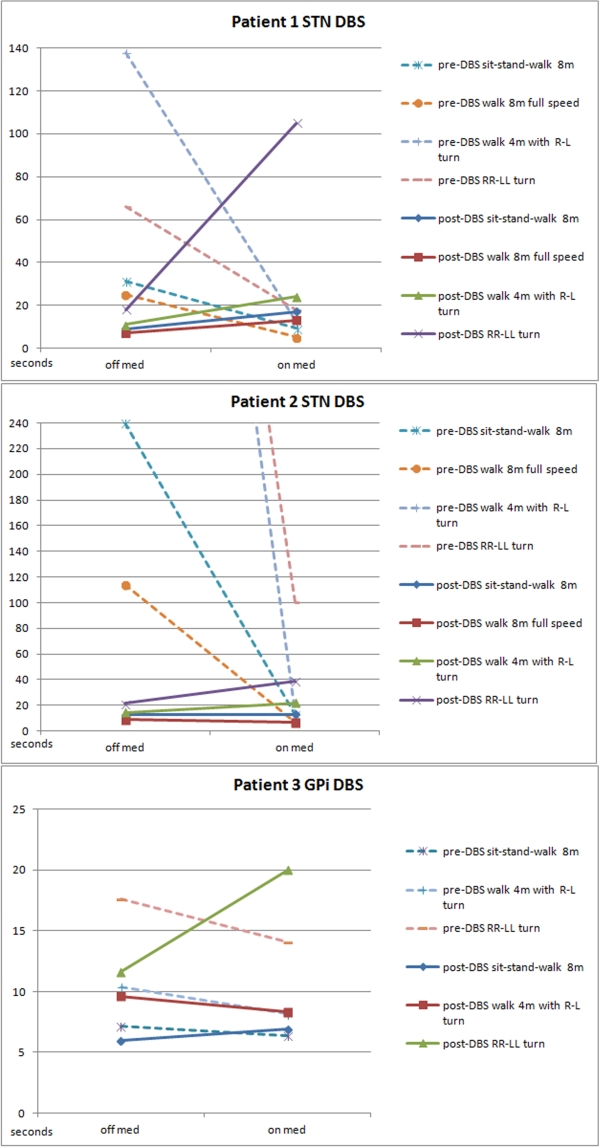Session Information
Date: Monday, June 20, 2016
Session Title: Surgical therapy: Parkinson's disease
Session Time: 12:30pm-2:00pm
Location: Exhibit Hall located in Hall B, Level 2
Objective: To present the first ever case series of on-state freezing of gait (FOG) after DBS surgery using dose-cycle gait evaluation.
Background: FOG is categorized into off-state FOG, unresponsive FOG, pseudo-on FOG, and on-state FOG. DBS, either in the sunthalamic nucleus (STN) or globus pallidus interna (GPi), is believed to improve off-FOG but not on-FOG. There have been some reports that DBS, either in STN or GPi, with certain setting can cause FOG. However, previously reported DBS related FOG was off-state or unresponsive FOG. Here we reported a case series composing 3 patients with DBS related on-state FOG.
Methods: From 2011 to 2015, we recruited 3 patients having DBS-induced on-state FOG, with 2 STN DBS and 1 GPi DBS.
Results: Case 1, 2, and 3 had Parkinson’s disease onset at the age of 50, 52, and 54 respectively and their pre-DBS levodopa equivalent doses were 1028mg, 1000mg, and 1036mg. Case 1 and 2 had bilateral STN DBS 9 years and 12 years after the disease onset while case 3 had bilateral GPi DBS due to PISA syndrome 12 years after the onset. Both case 1 and case 2 had off-period FOG preoperatively with good levodopa responsiveness and case 3 did not have FOG. One year after the DBS, case 2 had significant improvement in his FOG. Two years after DBS, FOG in case 1 became levodopa unresponsive. Four years after DBS in case 1 and 29 months in case 2, on-state FOG was detected. The 4-phase dose cycle showed best gait condition with on-DBS and off-medication. Their gait improved after levodopa reduced from 898mg to 600mg and from 750mg to 300mg with associated increase of the stimulation. In case 3, 2 years after DBS, she started to have on-state FOG and fall. Moving the stimulation contacts ventrally reduced the frequency of falling but the on-state FOG remained. All patients had improved walking during off-state after DBS. Their on-state FOG was detected in straight walking and was more prominent on turning  .
.
Conclusions: DBS related on-state FOG can happen in patients with or without previous FOG and with STN or GPi DBS. The mechanism of FOG is still unknown. On-state FOG has been linked to dopaminergic disruption in rhythm generation of alternating feet movements. STN stimulation acts on a different neurologic network from levodopa and may change dopamine regulation or nondopaminergic neurotransmitter systems. We suggest use dose cycle instead of questionnaires to evaluate post-DBS FOG. The treatment is to reduce the amount of medication.
To cite this abstract in AMA style:
Y.C. Tai, E. Everingham, D. Tsui, V. Fung, N. Mahant. DBS related on-state freezing of gait – A case series [abstract]. Mov Disord. 2016; 31 (suppl 2). https://www.mdsabstracts.org/abstract/dbs-related-on-state-freezing-of-gait-a-case-series/. Accessed December 8, 2025.« Back to 2016 International Congress
MDS Abstracts - https://www.mdsabstracts.org/abstract/dbs-related-on-state-freezing-of-gait-a-case-series/
